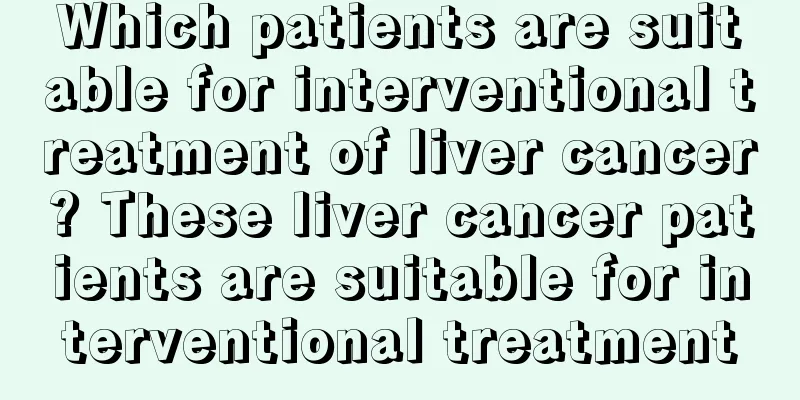Which patients are suitable for interventional treatment of liver cancer? These liver cancer patients are suitable for interventional treatment

|
Treatments for liver cancer include surgical treatment and non-surgical treatment. Surgery is mainly for early liver cancer. In the past, the concept of early liver cancer referred to tumors less than 5 centimeters, but now it usually refers to patients with tumors less than 3 centimeters. The treatment effect is very good for these patients. For patients who cannot undergo surgery, that is, patients with advanced tumors, or early tumors, but have medical diseases, such as heart disease or high blood pressure, etc., these medical factors and patients with severe liver cirrhosis cannot withstand surgery, so other non-surgical treatment methods can be used. After the 1980s, interventional therapy began to be widely used in the treatment of liver cancer in our country. We have a very deep understanding of this aspect, and the technology is also quite mature. Although there are still many academic differences in understanding about when and at what stage liver cancer patients should choose interventional therapy, the general trend now should be that interventional therapy should be the first choice for primary liver cancer that cannot be surgically removed. It does not matter whether these patients are in the early, middle or late stages, as long as they cannot be surgically removed, interventional therapy can be performed. Because the view of most scholars is: liver cancer that can be surgically removed should still be surgically removed. However, many studies in the past have shown that the effect of interventional treatment for small liver cancers is very good, and the five-year survival rate can reach more than 60%. For patients who can be surgically removed, because surgical resection is a radical treatment method, most scholars believe that surgical resection should be the first choice. Pathologically, liver cancer is divided into hepatocellular carcinoma and cholangiocarcinoma, as well as mixed types. Hepatocellular carcinoma accounts for the majority. Hepatocellular carcinoma is characterized by rich blood supply, and interventional treatment is most suitable. The first indication for interventional treatment is that the tumor has rich blood supply. Due to its special biological behavior, cholangiocarcinoma does not have a very rich blood supply. At the same time, cholangiocarcinoma is not very sensitive to chemotherapy and radiotherapy. Interventional treatment cannot perform embolization treatment well and cannot block blood vessels due to the poor blood supply, so the effect of interventional treatment is very limited. From this perspective, interventional treatment of liver cancer is mainly for interventional treatment of hepatocellular carcinoma. Metastatic liver cancer is also treated with interventional therapy. In our daily work, most of our interventional treatments are for patients with liver metastases. The most common are liver metastases from lung cancer, breast cancer, and digestive tract tumors, as well as female genital tumors and urinary system tumors. These tumors are prone to liver metastasis, especially digestive tract tumors. Interventional treatment is very effective for liver metastasis of digestive tract tumors and breast cancer, and is better than systemic chemotherapy. |
Recommend
A simple analysis of the causes of endometrial cancer
We all know that cancer is a very terrible diseas...
What is the best nursing care after lung cancer surgery? Five nursing tasks should be done after lung cancer surgery
Everyone will feel very painful when suffering fr...
Experts analyze the causes of cardia cancer in detail
Understanding the causes of cardia cancer is very...
Is nasopharyngeal cancer contagious?
According to expert statistics, the proportion of...
What metastases are prone to occur in breast cancer? Four common ways of breast cancer metastasis
The most terrible thing about cancer is metastasi...
What causes laryngeal cancer?
Nowadays, many men like to smoke. If they are not...
Can lotus leaves reduce inflammation? Can lotus leaves reduce inflammation?
In life, many women drink lotus leaf tea when the...
Nourishing the lungs ≠ preventing smog. This way of preventing smog is not entirely correct
In recent days, people have been asking about thi...
How much does surgery for cervical lymphoma cost
How much does it cost to have surgery for cervica...
Contraindications for medication for endometrial cancer
What are the contraindications for endometrial ca...
Bone cancer patients may also generally have lumps on the bone surface
Bone cancer patients may also have a mass on the ...
The difference between dizziness and vertigo
In fact, many people cannot distinguish between v...
Nails bend downwards
The nails bend downward, which is a more obvious ...
Is color Doppler ultrasound really useless for prostate cancer screening?
Is color Doppler ultrasound really useless for pr...
How to relieve nail injury
Nail pinching often occurs in daily life, so it i...









